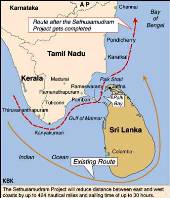 | « Back to article | Print this article |
 There seems to be no end to the 16-year-old war over the controversial Sethusamudram project.
There seems to be no end to the 16-year-old war over the controversial Sethusamudram project.
The project involves dredging the stretch of water between Tamil Nadu and Sri Lanka to make it navigable for ships.
At present, this is not possible, the water depth being only a few metres.
The legal battle is set to turn murkier, with the Centre and the Tamil Nadu government locking horns on the matter.
The Supreme Court has asked the Tamil Nadu government to make its stand clear within two weeks.
While a feasibility report by the R K Pachauri committee, set up by the shipping ministry, stated last year that the project was “unviable economically and environmentally”, the Centre is readying to go ahead with the ship-canal project.
The Centre filed an affidavit last month in the Supreme Court rejecting the Pachauri report, while the Tamil Nadu government is gearing up to file a fresh affidavit before the apex court soon, opposing the Centre’s plan to move ahead.
The Centre’s decision is based on studies done in the National Environmental Engineering Research Institute in 2004 and a government-appointed expert panel in 2007.
The Centre, in its affidavit to the Supreme Court, said, “The project has economic, navigational and strategic advantage, and therefore, the government has been pursuing the project.
"An expenditure of Rs 829.32 crore (Rs 8.29 billion) has already been incurred on the project.”
The Pachauri committee report had covered technical aspects, environmental impact, cost-benefit analysis, cultural impact, and law and order issues.
“Neither alignment 4A, nor alignment 6 meet the benchmark internal rate of returns of 12 per cent.
"Moreover, due to siltation, government will have to bear an additional dredging cost, too,” Pachauri added.
According to the Pachuari committee report, the project cost has increased by 101 per cent to Rs 4,504 crore (Rs 45.04 billion) within five years, compared with Rs 2,233 crore (Rs 22.33 billion) during the detailed project report in 2005.
Because of the uncertainties, the shipping ministry has kept a “token outlay” of Rs 100 crore for the 2012-17 period.
A shipping ministry official said, “The project started after technical studies and approvals. We feel it is an important and useful project.”
The dredging works at the Adam’s Bridge area was stopped following legal intervention in 2007.
On the environmental front, the report stated that 11 species of aquatic animals in the Palk Bay have received considerable scientific attention due to their economic importance.
This endangered species in the region include pearl oyster, sea horse, whale shark, sea turtle and sea cow.
Former shipping secretary Michael Pinto said, “The project is not worth it.
"It won’t give much savings.
"Large vessels would not be able to ply on the route anyway since the draft is just 10-11 metres.” The project was conceptualised to reduce the distance of ships coming from the west coast and Western countries to the east coast of India, Bangladesh and China, among others.
The report also states that the socio-economic profile of the fishermen in the villages of Gulf of Mannar coast is low, and more than 40 per cent of all families are in debt.
“The local people in 138 villages spreading across five districts are concerned that the creation of this channel would result in the reduction of their income due to fishery,” it said.
Religious organisations and the Bharatiya Janata Party, too, are against the project as the area comes under Ram Sethu, a mythological bridge believed to have been built by Lord Rama in the Palk Strait.
DISPUTE OVER ADAM’S BRIDGE
Graphic courtesy KBK